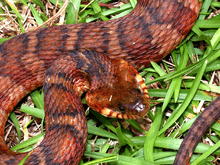Banded water snake
The banded water snake or southern water snake (Nerodia fasciata) is a species of mostly aquatic, nonvenomous, colubrid snake endemic to the central and southeastern United States.
| Banded water snake | |
|---|---|
 | |
| Scientific classification | |
| Kingdom: | Animalia |
| Phylum: | Chordata |
| Class: | Reptilia |
| Order: | Squamata |
| Suborder: | Serpentes |
| Family: | Colubridae |
| Genus: | Nerodia |
| Species: | N. fasciata |
| Binomial name | |
| Nerodia fasciata (Linnaeus, 1766) | |
| Synonyms | |
Description
Adults of the banded water snake measures from 61 to 106.7 cm (24.0 to 42.0 in) in total length, with a record size (in the Florida subspecies) of 158.8 cm (62.5 in) in total length.[7] In one study of the species, the average body mass of adult snakes was 464.3 g (16.38 oz).[8]
It is typically gray, greenish-gray, or brown in color, with dark crossbanding. Many specimens are so dark in color that their patterning is barely discernible. They have flat heads, and are fairly heavy-bodied. If irritated, they release a foul-smelling musk to deter predators.
Their appearance leads them to be frequently mistaken for other snakes with which they share a habitat, including the less common, venomous cottonmouth.
Habitat
Nerodia fasciata inhabits most freshwater environments such as lakes, marshes, ponds, and streams.[4]
Diet
It preys mainly on fish and frogs.[9] Using its vomeronasal organ, also called Jacobson's organ, the snake can detect parvalbumins in the cutaneous mucus of its prey.[6]
Reproduction
The species is ovoviviparous, giving birth to live young. The brood size varies from 9 to 50. Newborns are 200–240 mm (about 8-9.5 in) in total length.[10]
Subspecies
The three recognized subspecies of Nerodia fasciata, including the nominotypical subspecies, are:[11]
Taxonomy
Some sources consider Nerodia clarkii compressicauda and Nerodia clarkii taeniata to be subspecies of Nerodia fasciata.[12] Also, some sources have considered Nerodia fasciata to be a subspecies of Nerodia sipedon.[3][10][13]
See also
- Northern water snake
- Salt marsh snake
References
- Hammerson, G.A. (2007). "Nerodia fasciata". The IUCN Red List of Threatened Species. IUCN. 2007: e.T62237A12583389. doi:10.2305/IUCN.UK.2007.RLTS.T62237A12583389.en. Retrieved 23 December 2017.
- Boulenger, G.A. 1893. Catalogue of the Snakes in the British Museum (Natural History). Volume I., Containing the Families...Colubridæ Aglyphæ, part. Trustees of the British Museum (Natural History). (Taylor and Francis, Printers). London. xiii + 448 pp. + Plates I.- XXVIII. (Tropidonotus fasciatus, pp. 242-244.)
- Stejneger, L., and T. Barbour. 1917. A Check List of North American Amphibians and Reptiles. Harvard University Press. Cambridge, Massachusetts. 125 pp. (Natrix sipedon fasciata, p. 96.)
- Conant, R. 1975. A Field Guide to Reptiles and Amphibians of Eastern and Central North America, Second Edition. Houghton Mifflin. Boston. xviii + 429 pp. ISBN 0-395-19977-8 (paperback). (Natrix fasciata fasciata, p. 146 + Plate 20 + Map 100.)
- Smith, H.M., and E.D. Brodie Jr. 1982 Reptiles of North America: A Guide to Field Identification. Golden Press. New York. 240 pp. ISBN 0-307-13666-3 (paperback). (Nerodia fasciata, pp. 156-157.)
- Smargiassi, M. T.; Daghfous, G.; Leroy, B.; Legreneur, P.; Toubeau, G.; Bels, V.; Wattiez, R. (2012). Permyakov, Eugene A (ed.). "Chemical Basis of Prey Recognition in Thamnophiine Snakes: The Unexpected New Roles of Parvalbumins". PLoS ONE. 7 (6): e39560. doi:10.1371/journal.pone.0039560. PMC 3384659. PMID 22761824.
- Conant, R., and W. Bridges. 1939. What Snake Is That? A Field Guide to the Snakes of the United States East of the Rocky Mountains. D. Appleton-Century. New York and London. Frontispiece map + viii + 163 pp. + Plates A-C, 1-32. (Natrix sipedon fasciata, p. 103 + Plate 18, Figure 53.)
- Wright, A.H., and A.A. Wright. 1957. Handbook of Snakes of the United States and Canada. Comstock. Ithaca and London. 1,105 pp. (in 2 volumes) (Natrix sipedon fasciata, pp. 525-529, Figure 156.)
- The Reptile Database. www.reptile-database.org.
- ITIS (Integrated Taxonomic Information System). www.itis.gov.
- Schmidt, K.P., and D.D. Davis. 1941. Field Book of Snakes of the United States and Canada. G.P. Putnam's Sons. New York. 365 pp. (Natrix sipedon fasciata, pp. 221-222, Figure 72. + Plate 24, Center, on p. 344.)
- Species Nerodia fasciata at The Reptile Database
External links
| Wikispecies has information related to Nerodia fasciata |
| Wikimedia Commons has media related to Nerodia fasciata. |
- {{EOL}} template missing ID and not present in Wikidata.
Further reading
- Linnaeus, C. 1766. Systema naturæ per regna tria naturæ, secundum classes, ordines, genera, species, cum characteribus, diferentiis, synonymis, locis. Tomus I. Editio Duodecima, Reformata. L. Salvius. Stockholm. 532 pp. (Coluber fasciatus, p. 378.)
